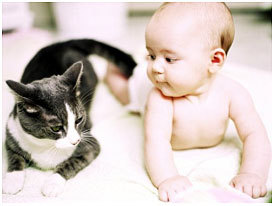|
Baby Proofing Directory
>
Misc.
Toddler Safety Tips >
Pet Safety >
Every year thousands of dogs and cats are sent to the pound
or given away because of a new baby’s arrival. Many parents
worry about how they will interact with each other, and ultimately
end up trying to find the pet a new home.
In most cases this is unnecessary! With a little bit of planning
and patience, baby and beast can learn to live side by side.
In fact, many pets will soon become protectors of your new baby
and they will end up being life long buddies as your child gets
older.
The key is to give them both time to get used to each other-
and you need to pay special attention to your pet’s needs
and fears. Here are some tips to make the transition easier.
|
 1. Timing is important. If you already have a pet, then you
should have no trouble integrating the baby into your daily
life. If you plan on getting a new pet after the baby arrives,
think twice about it. It may be too much stress for the new
pet to handle and they will be more likely to act out. 1. Timing is important. If you already have a pet, then you
should have no trouble integrating the baby into your daily
life. If you plan on getting a new pet after the baby arrives,
think twice about it. It may be too much stress for the new
pet to handle and they will be more likely to act out.
2. Go to the vet. Make sure that all vaccinations are up
to date with all cats and dogs. They should be checked for
internal parasites as well. It is important to plan ahead
and stock up on preventatives, flea control products, heartworm
medication etc. Once the baby comes you will likely be preoccupied
and these routine medications may be easily overlooked.
3. Make surrounding changes early and slowly. Pets just like
humans often fear change. If you are redecorating, do it slowly
giving your pet time to get used to the changes. If they have
a toy box, be careful not to move it as this will cause more
anxiety. Many parents will move a comfy dog bed into the baby’s
room, allowing their pet to explore the area and even nap
in the room. Always have a separate bed away from the excitement;
if you pet wants some baby-free time alone. Don’t scold
the dog or puppy for going into the room as this will only
cause resentment. Cats should be taught early on that the
crib is not a place to sleep.
4. Buy a baby doll. A few months before the baby arrives,
begin interacting with a baby doll (preferably one that cries.)
This will get your pet accustomed to the crying and all of
the attention. When your baby cries, cradle them with one
hand and pet your dog or cat with the other. This will help
calm them down. Place the baby in the crib or rock them in
the nursery, so the dog begins to make the association.
5. Get them used to baby sights, sounds, and smells. If you
have friends with children, ask to borrow them for a day.
This will give you a glimpse at how your pet will act. Smells
such as lotions, soaps, and baby powder are also helpful in
the process. If possible, have someone come home with a baby
blanket with the new babies smell. This will give your pet
time to get used to the smell, before the wiggly crying source
comes home.
6. Spend some time together. Once the baby comes home, try
to include your pet in the festivities. Talk to them while
you change diapers or nurse the baby. That way they will not
feel ignored or left out.
7. Let them investigate. Pets explore the world with their
noses, so let them smell the baby’s new toys and belongings.
Stop them before they begin to chew or mark their territory,
but let them explore a little.
8. Never leave the two of them alone together. Especially
once your baby starts crawling and walking. The best thing
you can do is supervise the situation whenever you can. If
you must leave the room, crate the dog or take the baby.
9. If you suspect allergies, don’t automatically blame
it on the dog or cat. Most allergies are food or soap related,
so rule out all possibilities before you try getting rid of
the pet.
10. Relax, your pet can sense your emotions and can tell
when you are upset or nervous. If you feel confident that
the two of them will get along, your pet will pick up on this
and act accordingly.
|

